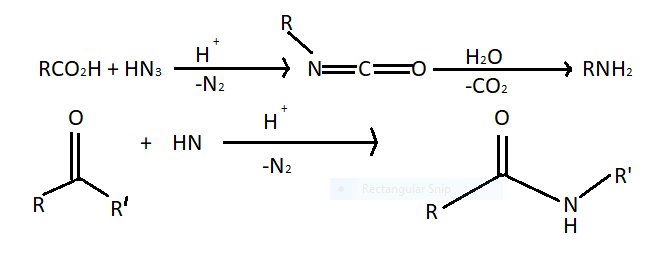
Nitrene is an intermediate in one of the following reactions:
A. Schmidt rearrangement
B. Beckmann rearrangement
C. Baeyer-Villiger oxidation
D. Curtius reaction
Answer
124.2k+ views
Hint : Nitrene is the nitrogen analogue of a carbene. It is an electrophile because it has five valence electrons. It is involved in many chemical reactions and acts as a reactive intermediate. It can be generated by two common ways. It can be generated by thermolysis or photolysis of azides with expulsion of nitrogen gas. Another way of generation of nitrene is the expulsion of carbon monoxide.
Complete step by step solution:
In Schmidt rearrangement alkyl migration over carbon nitrogen bonds takes place. This reaction refers to a reaction between an acid catalyst hydrazoic acid with electrophiles. Carboxylic acid forms amines through an isocyanate intermediate and ketones from amides. Nitrene is an intermediate in the following reactions.

In the Curtius reaction, the production of an isocyanate is accomplished by the thermal decomposition of carboxylic azides. The mechanism involves the alkyl shift of the $R$ group from carbonyl carbon to the closet nitrogen. The reaction has similarities with Schmidt reaction with acids but differs in that the acyl azide in the present case is prepared from acyl halide and an azide salt.

Hence option A and D both are correct answers of this problem because in both of the reactions nitrene is an intermediate.
Note : Nitrenes are highly reactive molecule species with a monovalent nitrogen atom which can exist in a singlet and triplet state. Nitrenes are more stable than carbene. It is because of greater thermodynamic stability of nitrene. As nitrenes are very reactive they are not isolated. The insertion of nitrene can be easily into a carbon to hydrogen covalent bond yielding an amine or amide.
Complete step by step solution:
In Schmidt rearrangement alkyl migration over carbon nitrogen bonds takes place. This reaction refers to a reaction between an acid catalyst hydrazoic acid with electrophiles. Carboxylic acid forms amines through an isocyanate intermediate and ketones from amides. Nitrene is an intermediate in the following reactions.

In the Curtius reaction, the production of an isocyanate is accomplished by the thermal decomposition of carboxylic azides. The mechanism involves the alkyl shift of the $R$ group from carbonyl carbon to the closet nitrogen. The reaction has similarities with Schmidt reaction with acids but differs in that the acyl azide in the present case is prepared from acyl halide and an azide salt.

Hence option A and D both are correct answers of this problem because in both of the reactions nitrene is an intermediate.
Note : Nitrenes are highly reactive molecule species with a monovalent nitrogen atom which can exist in a singlet and triplet state. Nitrenes are more stable than carbene. It is because of greater thermodynamic stability of nitrene. As nitrenes are very reactive they are not isolated. The insertion of nitrene can be easily into a carbon to hydrogen covalent bond yielding an amine or amide.
Recently Updated Pages
Types of Solutions - Solution in Chemistry

Difference Between Crystalline and Amorphous Solid

JEE Main Participating Colleges 2024 - A Complete List of Top Colleges

JEE Main Maths Paper Pattern 2025 – Marking, Sections & Tips

Sign up for JEE Main 2025 Live Classes - Vedantu

JEE Main 2025 Helpline Numbers - Center Contact, Phone Number, Address

Trending doubts
JEE Main 2025 Session 2: Application Form (Out), Exam Dates (Released), Eligibility & More

JEE Main Exam Marking Scheme: Detailed Breakdown of Marks and Negative Marking

JEE Main 2023 January 24 Shift 2 Question Paper with Answer Keys & Solutions

Learn About Angle Of Deviation In Prism: JEE Main Physics 2025

JEE Main 2025: Conversion of Galvanometer Into Ammeter And Voltmeter in Physics

JEE Main Login 2045: Step-by-Step Instructions and Details

Other Pages
NCERT Solutions for Class 11 Chemistry Chapter 7 Redox Reaction

NCERT Solutions for Class 11 Chemistry Chapter 5 Thermodynamics

JEE Advanced Marks vs Ranks 2025: Understanding Category-wise Qualifying Marks and Previous Year Cut-offs

NCERT Solutions for Class 11 Chemistry Chapter 8 Organic Chemistry

NCERT Solutions for Class 11 Chemistry Chapter 6 Equilibrium

NCERT Solutions for Class 11 Chemistry Chapter 9 Hydrocarbons




